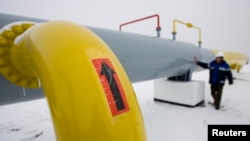
School was in session on November 28 in the northwestern Kazakh village of Berezovka when "almost simultaneously" 19 children between the ages of 10 and 15 and three teachers "lost consciousness." Ambulances came. The medics knew the symptoms. They had been picking up people the day before for the same reason.
Officials initially treated the incident as a mystery, and later offered questionable reasons for what they admitted seemed to be some sort of poisoning.
The approximately 1,400 residents of Berezovka had no doubt about the cause. They had been complaining for years about the nearby oil field.
By the evening of November 28, there were 31 people being treated for the "mystery" illness. On December 4, ambulances were called to take away six more schoolchildren for medical treatment; one of those children was going for the second time in a week.
Officials initially said three causes were possible: food poisoning; a leak in one of the still-ubiquitous gas canisters in use across the former Soviet Union; or it could have something to do with processing facilities at the Karachaganak oil and gas field several kilometers away.
On November 29, the provincial administration's press service said "doctors," whose names weren't given, reported four children were still under observation; one had anemia and another epilepsy.
It didn't matter to residents what the "doctors" were saying. RFE/RL's Kazakh Service, known locally as Azattyq, reported that people in Berezovka collected signatures demanding resettlement. They handed over the petition to officials on December 9. This is the fourth time residents have petitioned authorities for resettlement.
On December 4, the same day the last group of six ill children was picked up at school by ambulances, the prosecutor for West Kazakhstan Province, Serik Karamanov, said, "It has been established that at 14:19 on November 27 at the gas-processing complex of KPO B.V. [Karachaganak Petroleum Operating], there occurred a discharge of condensate for a period of two minutes," some 8.5 kilometers from Berezovka.
The prosecutor's office sent a request to the proper authorities to obtain information about the level of illness and mortality of residents of the Berezovka area in the past 10 years.
Such information is not difficult to find. A local organization called Zhasil Dala (Green Steppe) has been collecting this sort of information for years. Zhasil Dala has also led several campaigns demanding the government resettle Berezovka residents.
There is also the Washington-based NGO Crude Accountability (CA), which has been following the situation in Berezovka for more than a decade. CA filed a complaint on behalf of Berezovka residents in 2004, claiming the Karachaganak field was affecting the health of the villagers.
In August 2013, CA posted a 38-minute video titled "Five Kilometers Of Indifference":
"Five kilometers" refers to the "safe" distance that inhabited areas need to be from oil and gas fields. The film looked at life in Berezovka; the kind of toxins released into the air, ground, and water; local efforts to convince officials to help; and the relationship the people of Berezovka have with officials from the government and the consortium running Karachaganak.
The CA film notes that the NGO prepared independent reports about the health hazards in Berezovka and handed them over to the Kazakh government and KPO. According to CA, the reports were eventually rejected because the methodologies used for the research were not accredited in Kazakhstan.
The government and KPO funded their own report, which cleared Berezovka of having any adverse effects due to the Karachaganak field. In 2012, KPO installed towers to monitor air quality and provide early warning to Berezovka residents in case of an accident at the field.
Provincial prosecutor Karamanov said one of the two stations for environmental monitoring for Berezovka was turned off for repairs when the November 27 toxic discharge occurred.
The Karachaganak field is important for Kazakhstan, especially in light of the most recent delay at the Kashagan oil field in Kazakhstan's sector of the Caspian Sea.
Karachaganak is a major field. It contains more than 1.2 billion tons of oil condensate and more than 1.3 trillion cubic meters of gas. The gas in particular is a potential health hazard, as it contains far-higher-than-normal amounts of hydrogen sulfide, which acts as a nerve agent and can cause respiratory failure.
The partners in the consortium are BG Group and Italy's Eni, each with a 29.25 percent stake; U.S. company Chevron with an 18 percent stake; Russia's LUKoil with a 13 percent stake; and Kazakhstan's KazMunaiGaz (KMG) with a 10 percent stake. They have a contract for the field that runs through 2038.
KMG picked up its shares in Karachaganak fairly recently, acquiring its stake in late 2011 after what some regarded as strong-arm tactics. Kazakhstan had no presence in the lucrative project, admittedly due to unfavorable contracts Kazakh officials signed at the end of the 1990s. KMG gained its shares after Kazakh authorities launched investigations into KPO's finances and environmental practices that could have seen the consortium pay out hundreds of millions of dollars in fines.
The environmental fines stemmed from several years of complaints over practices for sulfur storage and disposal. The people of Berezovka say the sulfourous smell of rotten eggs is near constant in the village.
The cases against KPO were dropped and instead, KMG -- and by extension the Kazakh government -- received the shares they wanted in Karachaganak.
In the film "Five Miles Of Indifference," Svetlana Anosova, a resident of Berezovka, a member of Zhasil Dala, and someone familiar with the village's health problems, says, "We drink contaminated water, breathe contaminated air, and eat contaminated food."
-- Bruce Pannier, based partially on material from Azattyq correspondent Sanat Urnaliev and with help from Azattyq director Torokul Doorov (@Torokul)






